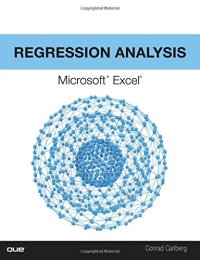
Ebook: Regression Analysis Microsoft Excel
Author: Conrad Carlberg
- Tags: Statistics, Education & Reference, Business & Money, Mathematical & Statistical, Software, Computers & Technology, Spreadsheets, Software, Computers & Technology, Microsoft Excel, Microsoft, Software, Computers & Technology, Probability & Statistics, Applied, Mathematics, Science & Math, Statistics, Applied, Mathematics, Science & Math, Business & Finance, Accounting, Banking, Business Communication, Business Development, Business Ethics, Business Law, Economics, Entrepreneurship, Finance, Human Resources, International Busine
- Year: 2016
- Publisher: Que Publishing
- Edition: 1
- Language: English
- epub
This is today’s most complete guide to regression analysis with Microsoft® Excel for any business analytics or research task. Drawing on 25 years of advanced statistical experience, Microsoft MVP Conrad Carlberg shows how to use Excel’s regression-related worksheet functions to perform a wide spectrum of practical analyses.
Carlberg clearly explains all the theory you’ll need to avoid mistakes, understand what your regressions are really doing, and evaluate analyses performed by others. From simple correlations and t-tests through multiple analysis of covariance, Carlberg offers hands-on, step-by-step walkthroughs using meaningful examples.
He discusses the consequences of using each option and argument, points out idiosyncrasies and controversies associated with Excel’s regression functions, and shows how to use them reliably in fields ranging from medical research to financial analysis to operations.
You don’t need expensive software or a doctorate in statistics to work with regression analyses. Microsoft Excel has all the tools you need—and this book has all the knowledge!
- Understand what regression analysis can and can’t do, and why
- Master regression-based functions built into all recent versions of Excel
- Work with correlation and simple regression
- Make the most of Excel’s improved LINEST() function
- Plan and perform multiple regression
- Distinguish the assumptions that matter from the ones that don’t
- Extend your analysis options by using regression instead of traditional analysis of variance
- Add covariates to your analysis to reduce bias and increase statistical power